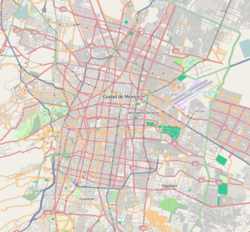Anahuacalli Museum
[Museo Diego Rivera Anahuacalli] Error: {{Lang}}: text has italic markup (help) | |
 Front view | |
| Established | 1964 |
|---|---|
| Location | Museo 150, San Pablo Tepetlapa, 04620, Coyoacán, Mexico City, Mexico |
| Website | www |
The Museo Diego Rivera Anahuacalli or simply Anahuacalli Museum is a museum located in Coyoacán, in the south of Mexico City.
The unique museum was conceived and created by muralist Diego Rivera, who, motivated by his own interest in Mexican culture, collected near 50,000 pre-Hispanic pieces during his life and projected a building to place and exhibit them. Rivera and his wife, the painter Frida Kahlo intended to build two museums as a legacy for Mexico.[1] The house that he and Kahlo lived in, known as "La Casa Azul" (The Blue House) now houses the Frida Kahlo Museum and is located 3.1 miles away, in the heart of the former village of Coyoacán. The Anahuacalli was completed after Rivera's death by architects Juan O'Gorman and Heriberto Pagelson as well as Rivera's own daughter, Ruth.
The museum is built of black volcanic stone (obtained from the terrain in which the Xitle volcano erupted). It takes the form of a pyramid. The museum items are collected from almost every indigenous civilization in Mexico's history. On the second floor, there is an exhibition room dedicated to the life and works of Rivera, as well as an observation deck.
The word Anahuacalli literally means "house of Anahuac" in Nahuatl.
Interior
The building forms a teocalli (god-house), and its design is notably influenced by the Teotihuacan culture as can be appreciated in the building’s boards, recreating the image of the rain god Tlaloc. It also shows Maya and Aztec influences, as can be appreciated in the hexagonal (Maya) and rectangular (Aztec) arcs that serve as entrances to the different showrooms.
There are funerary urns, masks and sculptures from the ancient culture of Teotihuacan and a smaller gallery next to the pyramid contains an exhibition of papier mache sculpture relating to the Days of the Dead, celebrated from October 31 to November 2.
References
- ^ "Museo "Historia"". Retrieved 19 September 2015.

